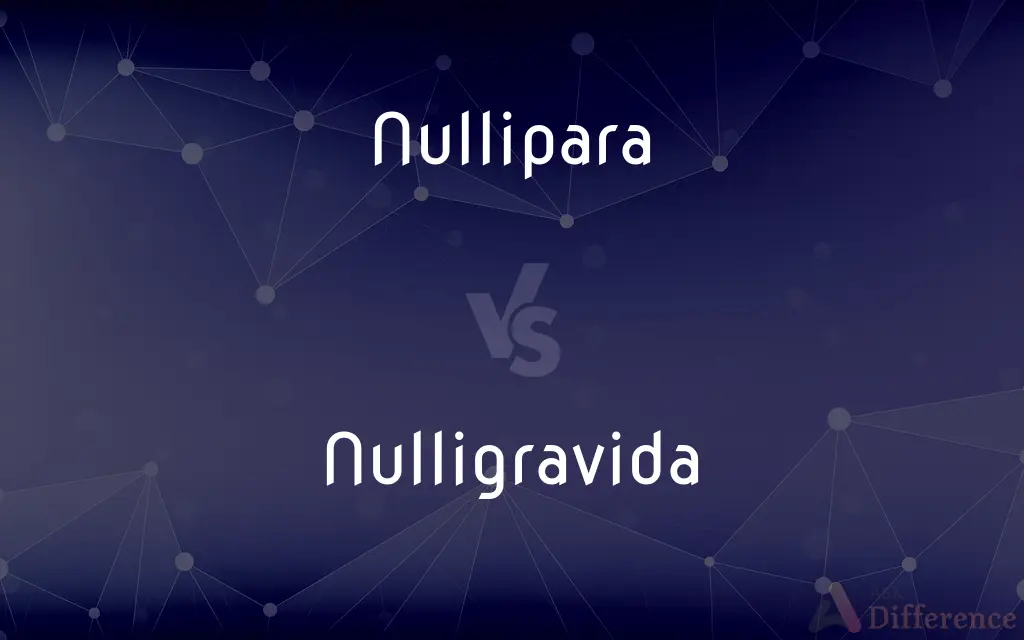Nullipara vs. Nulligravida — What's the Difference?
By Maham Liaqat & Fiza Rafique — Updated on March 25, 2024
Nullipara refers to a woman who has never given birth to a viable offspring, while nulligravida indicates a woman who has never been pregnant.

Difference Between Nullipara and Nulligravida
Table of Contents
ADVERTISEMENT
Key Differences
Nullipara is a term used in obstetrics to describe a woman who has never carried a pregnancy beyond the point of viability, meaning she has never given birth to a child who was able to survive outside the womb. This status remains regardless of whether she has experienced pregnancies that did not result in a live birth. On the other hand, nulligravida refers specifically to a woman who has never been pregnant. This distinction highlights the differences in pregnancy history and reproductive experience between the two terms.
While nullipara focuses on the outcome of pregnancies, essentially the ability to carry a pregnancy to a viable stage, nulligravida addresses the condition of never having been pregnant at all. This means a nulligravida woman has not experienced any pregnancy stages, including conception, implantation, or any period of gestation, whereas a nullipara may have experienced one or more pregnancies that did not culminate in a viable birth.
The medical and healthcare significance of these terms lies in their use for obstetric histories, allowing healthcare providers to understand a woman's pregnancy and childbirth history. For example, a nullipara may have different health considerations or risks compared to a nulligravida, especially if the former has experienced miscarriages or other pregnancy complications.
These terms also play a role in epidemiological studies and healthcare planning, as they help in identifying population segments with specific reproductive health needs or risks. For instance, a nulligravida woman may be the focus of preconception health advice, while a nullipara might receive guidance related to fertility or carrying a pregnancy to term.
Understanding the distinction between nullipara and nulligravida is crucial for providing appropriate healthcare advice, interventions, and support tailored to each woman's specific reproductive history and needs, highlighting the importance of precision in medical terminology.
ADVERTISEMENT
Comparison Chart
Definition
A woman who has never given birth to a viable offspring.
A woman who has never been pregnant.
Focus
Outcome of pregnancies (birth).
Pregnancy occurrence.
Pregnancy History
May have been pregnant but without viable birth.
Has not experienced pregnancy.
Medical Relevance
Used to assess risk factors for childbirth.
Used to assess overall reproductive health and preconception care.
Epidemiological Significance
Important for understanding childbirth-related health needs.
Important for preconception health planning and interventions.
Compare with Definitions
Nullipara
Applies regardless of pregnancy outcome short of live birth.
As a nullipara, she is attending classes to prepare for potential future pregnancies.
Nulligravida
Used to describe reproductive history in clinical settings.
Being nulligravida, she has numerous questions about what to expect in pregnancy.
Nullipara
A woman who has not given birth to a child who survived outside the womb.
Despite having been pregnant twice, she is considered a nullipara because she has not had a live birth.
Nulligravida
Indicates no history of pregnancy, including early stages.
Her nulligravida status is considered in her preconception health plan.
Nullipara
Relevant for assessing childbirth risks and experiences.
Nullipara women may have different health considerations during pregnancy.
Nulligravida
Relevant in both medical and epidemiological contexts.
Nulligravida individuals may participate in studies on fertility and preconception health.
Nullipara
Focuses on birth outcomes rather than pregnancy status.
She's a nullipara, having experienced miscarriages in the past.
Nulligravida
Important for pre-pregnancy health assessments.
As a nulligravida, she's focusing on optimizing her health before conceiving.
Nullipara
Used in obstetric histories to denote lack of live births.
Her medical record lists her as nullipara, important for her care team to know.
Nulligravida
A woman who has never experienced a pregnancy.
As a nulligravida, she's exploring fertility options with her healthcare provider.
Nullipara
A woman who has never given birth.
Nulligravida
A female who has never been pregnant.
Nullipara
A woman who has never carried a pregnancy beyond 20 weeks (one who has never given birth). It includes women who have experienced spontaneous miscarriages and induced abortions before the mid-point of pregnancy, but not women who have experienced pregnancy loss after 20 weeks.
Nullipara
(obstetrics) a woman who has never give birth to a child
Common Curiosities
What is the definition of nulligravida?
Nulligravida means a woman who has never been pregnant.
How do nullipara and nulligravida differ in medical relevance?
Nullipara has implications for childbirth and potential pregnancy complications, while nulligravida is focused on preconception care and fertility issues.
What is the significance of these terms in healthcare?
They help healthcare providers understand a woman's reproductive history for better care and treatment planning.
Does nullipara mean the same as infertile?
No, nullipara only indicates that a woman has not given birth to a viable child, not necessarily that she is infertile.
What does nullipara mean?
Nullipara refers to a woman who has never given birth to a child that was able to survive outside the womb.
Can a nullipara woman have been pregnant?
Yes, a nullipara woman may have been pregnant but did not have a viable birth.
Is there a specific medical test to determine nullipara or nulligravida status?
These terms are determined based on the woman's reproductive history rather than a specific test.
Why is it important to differentiate between nullipara and nulligravida?
Differentiating helps tailor healthcare advice and interventions to the woman's specific reproductive history and needs.
Can a woman be both nullipara and nulligravida?
Yes, if she has never been pregnant and, consequently, has never given birth.
Are nullipara and nulligravida terms only used in obstetrics?
While primarily used in obstetrics, these terms are also relevant in general healthcare and epidemiological studies.
What healthcare advice might a nullipara receive?
Advice may include managing pregnancy risks and preparing for a healthy pregnancy and childbirth.
How does nulligravida status affect healthcare planning?
It identifies women who may benefit from preconception health advice and fertility assessments.
Can nulligravida status change?
Yes, a nulligravida becomes a gravida once she becomes pregnant for the first time.
How do these terms impact epidemiological research?
They help in identifying specific population segments for studies on fertility, pregnancy, and preconception health.
What role do these terms play in family planning?
They are important in understanding a woman's reproductive goals and in planning for pregnancy and childbirth.
Share Your Discovery

Previous Comparison
Scheme vs. Schema
Next Comparison
Pedicel vs. PeduncleAuthor Spotlight
Written by
Maham LiaqatCo-written by
Fiza RafiqueFiza Rafique is a skilled content writer at AskDifference.com, where she meticulously refines and enhances written pieces. Drawing from her vast editorial expertise, Fiza ensures clarity, accuracy, and precision in every article. Passionate about language, she continually seeks to elevate the quality of content for readers worldwide.














































